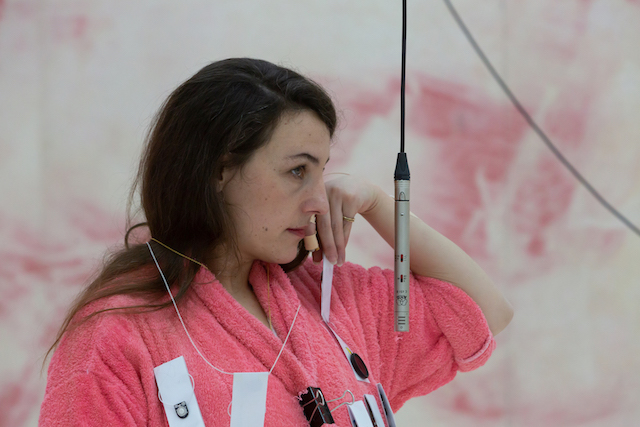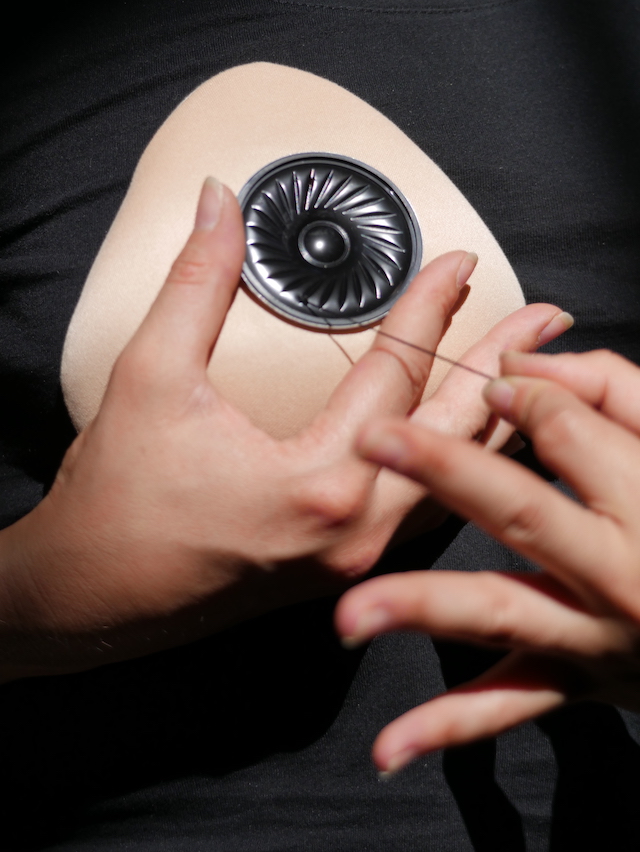Anne Le Troter, winner 2021
Anne Le Troter (1985) is an artist based in Paris. It was after writing two books, L’encyclopédie de la matière and Claire, Anne, Laurence, that she began to work cyclically on the way the speech of specific groups emerges, by cumulating exhibitions (often acoustic works) that lead to the production of written plays. Anne Le Troter thus invites groups of people, like ASMR (autonomous sensory meridian response) artists, to work with her (L’appétence, acoustic installation, 2016, Salon de Montrouge and Palais de Tokyo Prize). After working on a form of commercialisation of speech — through a cycle of acoustic installations created around the figure of the telephone pollster, a cycle spread over two solo exhibitions and a group exhibition (Les mitoyennes at the BF15 in 2015, Liste à puces at the Palais de Tokyo in 2017 and Les silences après une question at the Institute of Contemporary Art in Villeurbanne in 2017) — today Anne Le Troter’s work is leaning towards the anticipation genre. Invited by the Pernod Ricard Foundation, the Biennale de Rennes, Le Grand Café—Contemporary Art Centre in Saint Nazaire, the Nasher Sculpture Center in Dallas and the Centre Pompidou, the artist has begun a new writing cycle, focusing on the idea of biography, fiction and utopia. In 2020, she was awarded the Villa Kujoyama Prize (Kyoto).

Anne Le Troter, view of the performance Même pas de mots in the installation “Parler de loin ou bien se taire”, 2019. Acoustic work, 20 min, installation, various materials, variable dimensions. Production Le Grand Café – Contemporary Art Centre, Saint-Nazaire and Nasher Sculpture Center (US), Collection Centre Pompidou / Photo credit: Hervé Veronese. Courtesy Anne Le Troter & galerie frank elbaz
The artistic project
A project for a medico-social radio station hosted by the authors of anonymous works referenced in the Marc Vaux photography collection.
“As I usually work a great deal with sound archives that I produce or discover, I naturally went looking for them in the Marc Vaux photography collection. I found them in the interstices of the photographic images, in other words, in the unrecorded narratives that exist between these images by anonymous authors. Just like Marc Vaux, who established a mutual aid residence for artists and intellectuals, these anonymous authors, whom I would call “Volunteers” will seek to set up a medico-social radio station to give voice to the images that constitute this photographic collection. In a desire to give them an identity, they speak mainly of their biological bodies, the bodies of art workers and the condition they are in.
Hence, with the assistance of the medical corps, what this radio station plans to broadcast is a rereading of art history from 1920 to 2021, viewed through the prism of medicine. The history of medico-social radio is located in the Montparnasse neighbourhood. The tower had a radio wave relay station in the 1980s and broadcast local radio station programmes, particularly 95.2 FM that included: Médico Social, France Lecture, Sport et Musique and the Paris FM2 radio station. I want to revive Montparnasse’s radio history by inviting actors from Radio Citron, for example (inspired by La Colifata station), to play the roles of the authors of the anonymous works that are part of the Marc Vaux photography collection.
Once this medico-social radio station has been set up, the sound archives created will be broadcast in the form of performed radio plays that will be audible through acoustic garments. These acoustic garments will be orchestrated by performers who will reveal the words spoken by others, like so many portable radios ready to broadcast the voices of anonymous authors in the city. Those who spread the words of others will work as antennas or serve as relays.
Starting from the observation that sound, voice and speech are intrinsically mobile, and it is amplification that made sound partially sedentary, I would like to offer a mobile acoustic installation, outdoors, that works thanks to people who carry the sound with them, people who carry voices with them and who would be willing to host other people’s words on their own bodies. The words would be seen as organs, seeking to bring a society “to life” in our present world, reviving it by carrying these voices around.”

© Antonin Horquin. Courtesy Anne Le Troter & galerie frank elbaz
Artistic committee 2021
Each year the grant is awarded by an artistic committee formed of with professionals from the art world. This year, the committee brings together:
Jagna Ciuchta, Artist
Mica Gherghescu, Head of Department for Research Services at Bibliothèque Kandinsky, Paris
Béatrice Gross, Independant curator and critic
Émilie Renard, Director of Bétonsalon – Centre for Art and Research
Manuel Segade, Director of Centro de Arte Dos de Mayo (CA2M), Madrid
Euridice Zaituna Kala, Artist (2019 grant winner)
ADAGP & Bétonsalon – Centre for Art and Research Grant
ADAGP & Bétonsalon, sharing common vocations - working closely with artists, highlighting visual heritages and art history - co-created a research program that aims at developing the work of an artist on the circulation and reproduction of images, in relation to the research on the Marc Vaux Archive led with Centre Pompidou MNAM-CCI.
This grant, amounting to 20 000 euros, aims to accompany an artist in the development of a research, during 3 months, on problematics related to representation, production and dissemination of images, based on the Marc Vaux Archive and on academic research conducted on this archive. This research can be part of the field of art (rereading of art history, exploring unknown and marginalized life journeys, reflecting on the actual production of images...) but also in the wider field of the production of images in a world saturated with information (political, eco¬nomic, scientific, journalistic…).
The 20,000 euros of this grant are intended for covering the artist’s fees (5 000€), their production budget (10 000€), the costs of supporting their project (5 000€) and (if necessary) their accommo¬dation costs in Paris.
Initiated in 2017, this program is conceived as an artistic research platform dedicated to the experimentation of non-linear models of knowledge production and distribution between researchers, contemporary artists, associations, cultural institutions and the general public.
The former laureates were franck leibovici (2017), Liv Schulman (2018) and Euridice Zaituna Kala (2019).
This call is open to artists living or working in France.
The application must be sent before May 2, 2021.
Call for applications (in French).
About ADAGP
Created in 1953, ADAGP is the French royalty collecting and distribution society in the field of graphic and visual arts.
Supported by a global network of almost 50 sister companies, it currently represents more than 110 000 artists in all disciplines of visual arts: painting, sculpting, photography, architecture, design, comic strips, manga, illustrating, street art, digital creation, video art and so on.
ADAGP manages all the property rights held by artists (resale right, reproduction right, right of public communication, collective rights), for all modes of use: books, media, advertising, merchandise, auctions, gallery sales, television, video on demand, websites, user sharing platforms and so on.
Thanks to its rich, diverse catalogue, it is now one of the biggest collecting societies in the world.
About Marc Vaux Archive at Bibliothèque Kandinsky
A former carpenter who took up photography after being injured in the First World War, Marc Vaux began in the 1920s to carry his photographic chamber around the various artist studios of Montparnasse and Paris. By the early 1970s he had produced over 127 000 photographs. The study of this collection, which is now housed at the Centre Pompidou and whose digitization has just been completed, makes it possible to draw up a portrait of Paris as a creative centre with a hybrid and transnational language, nourished by individual histories or political and artistic commitments too often blended into the linearity of the official narratives of a homogenous modernity.
The fund can be consulted on the website Archives et documentation of the Centre Pompidou.]
Share